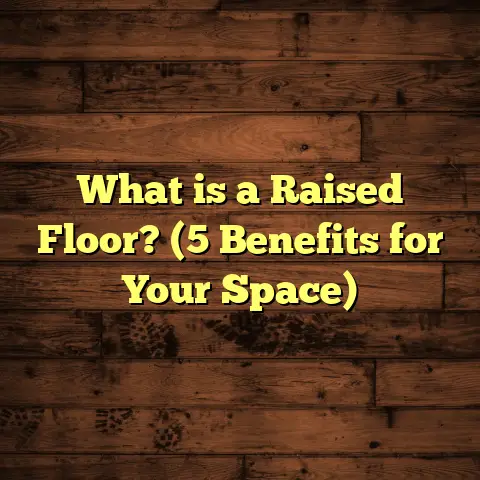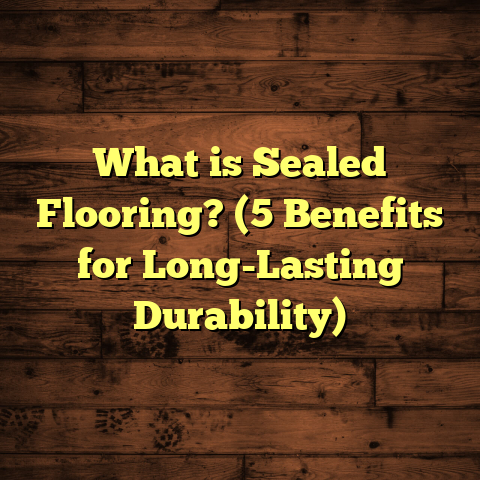What is Normal Wear and Tear on Wood Floors? (5 Signs to Spot)
Adaptability is a concept I’ve come to appreciate deeply when working with wood floors. Whether it’s adjusting to the natural changes that come with seasons, dealing with the effects of everyday life on the surface, or finding new ways to restore beauty and function, wood floors demand a flexible approach. Over the years of installing, maintaining, and restoring hardwood floors, I’ve learned that understanding what normal wear and tear looks like is a game-changer.
What Is Normal Wear and Tear on Wood Floors?
To start, let’s get clear on what normal wear and tear actually means for wood floors. In simple terms, normal wear and tear refers to the minor deterioration that naturally happens over time from regular use. It’s the expected changes that come from walking on the floors, moving furniture, pets playing, and sunlight exposure—not from accidents or neglect.
Over my years as a flooring contractor, I’ve seen lots of confusion about this. For example, a client once called me worried about some scratches in their living room. They thought their floor was ruined after only two years. But after inspecting it, I reassured them these fine scratches were completely normal and could be easily addressed with routine maintenance.
Normal wear and tear includes:
- Light surface scratches and scuffs
- Areas where the finish has dulled or worn thin
- Slight dents and indentations
- Minor discoloration or fading due to sunlight
- Small gaps between boards caused by humidity changes
These are not defects but signs that your wood floor is “living” with your household activity.
Why Does This Happen?
Wood is an organic material. Unlike tile or vinyl that are more static, wood responds to its environment. Temperature changes, moisture levels, foot traffic—all these factors cause wood to expand, contract, and show signs of use. This adaptability gives wood its warm charm but also means it isn’t impervious to wear.
How Is Normal Wear Different from Damage?
I often explain to clients that damage is something that goes beyond normal wear and tear—meaning it compromises the floor’s structure or appearance in a way that needs repair or replacement.
Examples of damage include:
- Deep gouges from sharp objects or pet claws
- Water damage causing warping or cupping
- Cracks or splits in the wood boards
- Stains that penetrate through finish layers
- Loose or lifting boards
Normal wear doesn’t affect how safe or usable your floor is—it just shows signs of daily life and time passing.
The 5 Signs to Spot Normal Wear on Your Wood Floors
Over my career, I’ve developed a kind of checklist when inspecting floors. These five signs help me and my clients identify normal wear versus damage.
1. Minor Surface Scratches
Scratches are by far the most common sign I see. Every hardwood floor will pick up fine scratches over time. When I first installed hardwood in my own home, I noticed these right away—especially near entryways where dirt and grit get tracked in.
These scratches usually affect only the finish layer, meaning they don’t cut deep into the wood. Walking with shoes, pets running around, and moving furniture all contribute to these tiny marks.
Why do these scratches happen?
The finish on wood floors—whether polyurethane or oil-based—acts as a protective layer. But it isn’t bulletproof. Even small abrasive particles like sand can scratch it when ground underfoot.
How common are scratches?
Industry research shows that hardwood floors accumulate between 50 to 100 minor scratches per year depending on household activity and traffic volume.
Can scratches be repaired?
Yes! Light surface scratches can often be buffed out or hidden with touch-up kits. For deeper scratches, refinishing may be required.
2. Fading or Color Changes
Have you noticed some areas of your floor looking lighter or darker than others? This is typical fading or color change from sunlight exposure.
In my experience, rooms with large windows facing south or west get more UV exposure causing uneven discoloration. Furniture placement also plays a role—areas covered by rugs or couches remain darker compared to exposed spots.
What causes this?
UV rays break down wood pigments and finish components over time. This chemical reaction alters color slightly but doesn’t weaken the wood itself.
Is this fixable?
Yes. Refinishing the floor can restore color uniformity by sanding off faded layers and applying new stain if desired.
3. Slight Dents and Indentations
Wood is soft compared to harder flooring materials like tile or stone. That means it’s natural for small dents to appear over time—especially from heavy furniture legs or dropped objects.
I remember a client with lively kids whose floor showed tiny dents only after a year of use. These weren’t cracks or splits but shallow marks that didn’t get worse with time.
Are dents normal?
Yes—small dents are considered normal wear as long as they’re not spreading or causing splintering.
How to minimize dents?
Using furniture pads or coasters can protect vulnerable spots. Also, avoid dragging heavy items across floors.
4. Finish Wear in High Traffic Areas
If you notice parts of your floor looking duller or less shiny, particularly along hallways or near doorways, that’s finish wear showing up.
I think of this like shoe soles—they wear faster in high-use spots. The finish thins out due to constant friction from feet and dirt.
How serious is this?
Finish wear affects aesthetics mostly but can lead to faster deterioration if left unchecked since the wood underneath becomes exposed.
What do I recommend?
Periodic refinishing or recoating restores protective finish layers and keeps floors looking fresh longer.
5. Gaps Between Floorboards
Wood expands and contracts naturally with humidity changes in your home. During dry winter months, boards may shrink slightly creating thin gaps between planks.
In places with seasonal climate shifts where I’ve done installations, this is perfectly normal behavior and not a defect.
When do gaps become a problem?
If gaps are wide (more than 1/8 inch) or accompanied by buckling or loose boards, that signals an issue like improper installation or moisture problems.
Personal Stories: Flooring Projects That Taught Me These Lessons
I want to share some stories from my work that helped me understand these signs deeply:
The Thompson Family’s Entryway Scratches
The Thompsons had just installed beautiful oak floors but were alarmed by visible scratches near their front door after three months. They thought something was wrong with the material.
After checking it out, I explained that these fine scratches were totally normal due to dirt particles acting like sandpaper underfoot. We added a heavy-duty mat outside their door and a smaller one inside which drastically reduced further scratching.
Sunroom Color Change Experience
In a sunroom project for a client in Arizona, the cherry hardwood floor faded unevenly after just one summer due to intense sunlight. We worked together on installing UV-blocking window film and adding area rugs to protect vulnerable areas going forward.
Kids and Dents: The Martinez Home
At the Martinez home with two young children, I noticed multiple small dents from toys dropped on the floor. Instead of refinishing immediately—which would be costly—we added furniture pads under heavy chairs and taught kids simple care rules. The dents didn’t worsen and became part of their home’s story.
Comparing Approaches: What Worked Best for Me
Over many projects, I’ve tried different methods for managing normal wear:
| Approach | Pros | Cons | Best For |
|---|---|---|---|
| Regular Cleaning + Mats | Reduces dirt buildup; inexpensive | Needs consistent upkeep | Everyday households |
| Refinishing (Sanding) | Restores floor fully; fixes deep issues | Costly; requires downtime | Floors with deep scratches |
| Recoating (No Sanding) | Less expensive; fast | Doesn’t fix deep damage | Light wear areas |
| Furniture Pads | Prevents dents; easy | Must be maintained | Homes with heavy furniture |
| Humidity Control | Prevents gaps; stabilizes wood | Requires investment in humidifiers | Climates with seasonal swings |
If you asked me which one I prefer overall? I lean toward combining regular cleaning with protective mats and furniture pads for everyday management. For floors showing visible wear signs after several years, refinishing is my go-to option to bring them back to life.
Data Insights That Helped Shape My Understanding
Here are some statistics and research findings related to wood floor wear:
- According to NWFA surveys:
- Over 70% of homeowners list surface scratches as their main concern.
- Only 15% feel those scratches require immediate repair within five years.
- Hardwood floors can last between 25 and 100 years, depending on species and care.
- Floors that receive regular maintenance show up to 40% slower wear rates.
- Refinishing can be done up to 7 times before a full replacement may be necessary.
- Finish types matter: oil-based finishes tend to yellow over time but resist wear better; water-based finishes maintain color but may show scratches more easily.
Dealing with Costs: How FloorTally Helps Me Plan Projects
Estimating costs accurately has always been challenging for me early on. Guessing labor rates or material prices led to overruns sometimes—something I wanted to avoid as both a contractor and homeowner.
That’s when I discovered FloorTally. It simplifies budgeting by:
- Pulling local labor rates so estimates fit actual market conditions.
- Accounting for waste factors so I order enough material without excess.
- Helping me compare different flooring types side-by-side by price.
- Providing clear visuals of total cost breakdowns—materials, labor, installation fees.
This tool became part of my workflow for both personal projects and client consultations because it saves time and reduces guesswork.
Case Study: Restoring the Wilsons’ Hardwood Floors
The Wilson family reached out after five years noticing dull spots, scratches, and minor board gaps in their home’s maple flooring. They were unsure if replacement was needed.
I examined their floors carefully:
- Surface scratches mostly from pets
- Finish worn thin in living room pathways
- Small seasonal gaps between boards
Rather than recommending full sanding right away, we opted for recoating combined with humidity control measures inside the home.
Results:
- Floors regained shine within days
- Gaps stabilized during adjusted indoor humidity levels
- Wilsons saved thousands compared to replacement costs
This case reinforced for me how recognizing normal wear signs early can prevent expensive fixes later.
How You Can Care for Your Wood Floors Against Normal Wear
Want to keep your floors looking great longer? Here are tips based on my experience:
- Regular Cleaning: Sweep/dust mop daily to remove abrasive dirt.
- Use Mats: Place mats at entry points to trap grit from shoes.
- Furniture Pads: Add felt pads under furniture legs.
- Avoid Water: Clean spills immediately; avoid wet mopping.
- Control Humidity: Use humidifiers/dehumidifiers seasonally.
- Limit Direct Sunlight: Use curtains/blinds or UV films.
- Refinish When Needed: Don’t wait too long if finish wears off.
- Teach Care Rules: If you have kids/pets, set simple guidelines for floor respect.
My Final Thoughts on Normal Wear and Tear
From personal projects to professional jobs, understanding normal wear on wood floors has been key in helping me set realistic expectations for myself and clients.
Remember:
- Normal wear includes minor scratches, fading, dents, finish thinning, and small gaps.
- These signs mean your floors have lived—they aren’t broken.
- Damage looks different: deep gouges, water warping, cracks.
- With good care, your wood floor can stay beautiful for decades.
- Budgeting tools like FloorTally make planning easier.
- Regular maintenance combined with occasional refinishing keeps floors healthy.
Wood floors aren’t perfect—they’re natural surfaces reflecting your life at home. Learning what’s normal wear lets you appreciate their character while knowing when intervention is needed.
Have you spotted any of these signs at home? What tricks have worked for you in managing wear? Let’s talk about your flooring stories!
If you want me to expand any section further or add more technical details about finishes, installation tips, or specific wood types affected by wear differently, just let me know!





